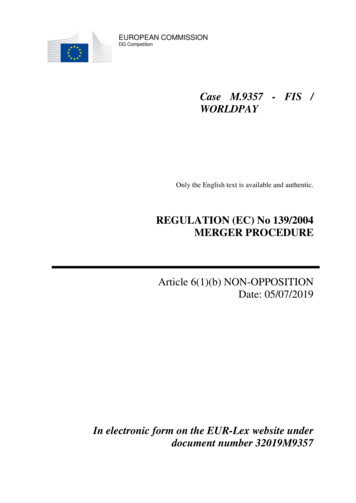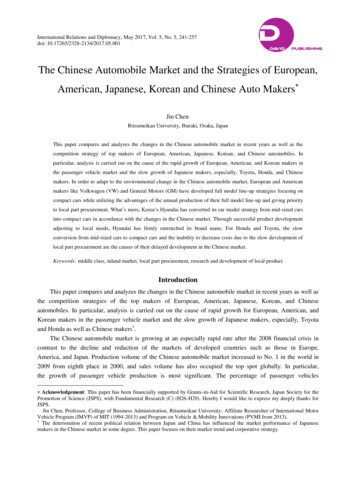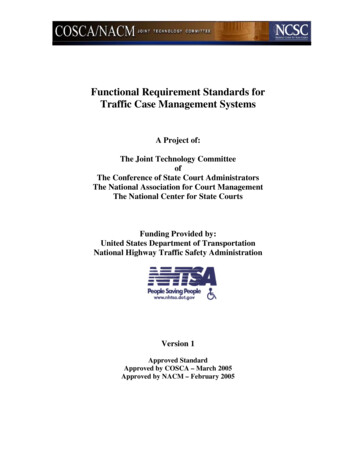
Transcription
UPPSALA UNIVERSITYDepartment of Business StudiesMaster ThesisSpring Semester 2013The Case of Geely Acquiring Volvo CarA Study on Low Brand Equity Acquiring High Brand EquityAuthors: Yuan Shi & Xiaoshu ZhengSupervisor: Ulf OlssonDate of submission: 4th June, 2013
AbstractMuch previous research has studied high brand equity acquiring high brand equity or highbrand equity acquiring low brand equity. However, very little research has been conducted tounderstand how that low brand equity acquiring high brand equity changes the low brand equityespecially in China. This paper is on the case of Geely Group acquiring Volvo Car which was atypical acquisition of a high brand equity company by a low brand equity company. The aim ofthe paper is to verify whether this type of acquisition could increase the acquirer’s brand equityevaluated by consumers. This paper selects two brand strategies, ‘the house of brands strategy’and ‘the endorsed brand strategy’, as the study objects of post-acquisition brand integration, andattempts to find the differences on consumers’ expectations and what is better suited for the newjoint company. Therefore, a survey research strategy was used in this paper. A conceptualframework which included brand loyalty and perceived quality was developed from a review ofthe existing literature. Samples of data collected from Chinese consumers have been analyzed forthe changes of consumers’ evaluation on the brand equity of Geely after its successful acquisition.Our research result proved that, a low brand equity company could enhance its brand valuethrough acquiring an internationally known brand. After the acquisition, no matter what brandstrategy applied, consumers had a more positive attitude towards the brand. The conclusionreached was that firms should be careful to choose an acquisition strategy by considering itsstrengths. But when faced with a decision of acquisition, the most important thing is to focus onthe final success of the acquisition, while the brand integration strategy might be adjustedflexibly.Keywords: Brand Acquisition from China, High Brand Equity, Low Brand Equity, House ofBrands Strategy, Endorsed Brand StrategyI
Table of Contents1. Introduction . 11.1 Background . 11.2 Problem Statement . 21.3 Research Objective . 32. Literature Review . 52.1 Brand Acquisition . 52.2 Brand Equity . 52.3 Measuring Brand Equity . 82.4 Brand Strategies in Post-M&A . 103. Methodology . 143.1 Research Strategy . 143.2 The Research Design and Operationalization . 153.3 Samples and Data Collection . 183.4 Methods of Testing Hypotheses . 193.5 Limitations . 204. Empirical Results and Statistical Analyses . 224.1 Sample Descriptions . 224.2 The Result of Brand Equity with Geely and Volvo . 234.3 The Result of Brand Equity of Geely after the Acquisition . 244.4 The Result of Different Brand Strategy Applying In Geely Group after the Acquisition . 275. Discussion. 326. Conclusion . 346.1 Managerial Implications . 346.2 Suggestion for Future Research . 35References . 36Appendix 1 . 39Questionnaire for brand equity changes after the acquisition and different brand integrate strategy �后不同品牌策略的影响调查 . 39II
1. Introduction1.1 BackgroundWith the rapid development of economic globalization, an international Merger andAcquisition (M&A) wave is sweeping the world and it has become an important strategy whichhelp companies to obtain competitive advantages in the global business environment (ChinaDaily, 2007). More and more multinational companies use cross-border M&A to achieve globalresources allocation. Economic globalization brings not only opportunities for development butalso challenges. And it is changing the global economic framework during its process (FinancialTimes Report, 2011).In recent years, the acquirers come from not only multinationals in developed countries butalso multinationals in developing countries (e.g., China). Statistics from the Chinese Ministry ofCommerce in Foreign Investment and the Economic Cooperation Department showed thatChinese investors made direct investment overseas in 4425 enterprises in 141 countries andregions with the amount of US 77 billion, up by 29% year-on-year in 2012 (MOFCOM statistic,2013). The growing of overseas investment indicates the trend of Chinese enterpriseinternationalization. But the various investment approaches also increase the challenge.However, most foreign studies focus on the cases of high brand equity acquiring high brandequity or high brand equity acquiring low brand equity, but cases happening in China currentlyare different. Kumar’s (2009) study showed that the acquirer is often a low-cost commodityplayer in developing countries, while the acquired company is a value added branded-productscompany. Accordingly Eckhardt and Bengtsson (2010:210) argue that “In China, brands emergedoutside of a capitalist context and served primarily social functions. How brands developed outof it, demonstrating that brands can develop in varying ways”. By comparison, brandconsciousness is weak in China due to the fact that the Chinese market faced rigid regulations(Financial Times Report, 2011). In addition, it is time and resource consuming to create aninternational brand. In order to enhance their international reputation, Chinese companies useM&A strategies to acquire high brand equity companies to develop their own brand, which inturn helps facilitate brand entry into the global market.Literature shows that there are many possible motivations for M&A (Kumar and Blomqvist,2004; Mann and Kohli, 2012), and the two key motivations for Chinese companies acquiringinternational companies are: 1) the worldwide brand market and technical resources will helpshorten the journey of the internationalization of Chinese brands. 2) The international brands canhelp the local brands to build the recognition in the global market.1
Kumar and Blomqvist (2004) stated that companies that use M&A growth strategies have toconsider how to brand the acquired company and how to manage the migration of the brand tothe new company. It is very important to ensure that customers remain satisfied and loyal to thebrand. Simmons et al. (2000:211) stressed that “high brand equity not only increase theeconomic value of low brand equity, but that it also influence consumer’s perception andconfidence in low brand equity”.1.2 Problem StatementThere are many reasons why countries like China use M&A strategy to enter the globalmarket. Some of the reasons to this approach according to Kumar’s (2009) is to enable theacquirer to obtain new technologies, brands, and consumers in foreign countries instead of tolower costs or break into new countries. The acquisition of Geely-Volvo actually represents anew form of acquisition, which is low brand equity acquiring high brand equity. This kind ofM&A is rising in the emerging market countries. Since Lenovo made its successful acquisition ofIBM's personal computer business in 2005, brand acquisition has become one of the mainapproaches for entering into the global market and to establish an international brand for Chinesecompanies. However, this kind of opportunity does not exist all the time. For example, due to theaftermath of the financial crisis in 2008, General Motors announced the sales of Saab andHummer. Also Ford announced the sale of Volvo in 2009. Chinese car enterprises swarmed intobuying those brands. In the end, Zhejiang Geely Holding Group of China (Geely) announced thesuccessful acquisition of Volvo Cars from Ford Motors Co In March 2010, whiles GM failed tosell Saab several times and discontinued Hummer (The Economists, 2010). These high-profileacquisitions gained attention in China.When Geely successfully acquired Volvo Car in 2010, it shocked the world immediately.Geely was established in 1986 and launched its auto manufacturing business in 1997. It isinconceivable that an un-known company with only 13 years of experience in car manufacturinghas acquired Volvo which has existed for more than 80 years and is well-known globally. Tosome extent, this is a typically case of a low brand equity company acquiring a high brand equitycompany. But some points of view showed that the acquisition would make the brand with highequity weak and enhance the lower one at the same time. Critics also pointed out that enterprisesshould be more careful to avoid useless brand acquisitions (Wang, 2011).This paper focuses on low brand equity Chinese company acquiring high brand equitycompany. Do these acquisitions indeed enhance the acquirer’s brand equity? Do consumers’attitudes towards the acquirer’s brand equity change positively after the acquisition? Furthermore,2
it is important to evaluate the brand strategy in the long term in order to improve the success ofM&A (Kumar and Blomqvist, 2004). Strategic M&A activities can not only change the firm’sinternally but also can transmit related information to external stakeholders, which has influenceon the perceptions of the brand. So a successful acquisition is just the first step, it is critical thatthe suitable brand integration strategy implemented in post-acquisition management can obtainlong-term success. For example, The market leaders in Chinese multimedia equipmentmanufacturing industry, TCL Group, announced they would exit the European market in 2006,after merged with France-based Thomson SA and Alcatel a mobile phone manufacturingcompany in 2004, this shows a harsh lesson in post-M&A management (Nicolas, 2010).Back to the case of Geely acquiring Volvo Car, in the last two years, Geely changed itsbrand logo, and let Volvo Car operate independently. But the brand of Volvo is shared with theVolvo Group; therefore, how to utilize the Volvo brand effectively to bring positive market effectis critical. The brand strategy of Geely needs to be carefully considered. Although the brandstrategy is the responsibility of the company, the study still needs to consider the expectationsand responses of consumers.This brings us to our research question.-In what way does the customer-based brand equity change after acquisition and brandintegration, when a low brand equity company acquires a high brand equity company?To understand the research question better, the empirical study of Geely’s brand after itsacquisition with Volvo Car will focus on the Chinese market, the following sub-questions aredeveloped:1. How do customers distinguish low brand equity and high brand equity like Geely andVolvo Car?2. How does Acquirer’s (Geely) brand equity change after the acquisition based oncustomer evaluation?3. How does Acquirer’s (Geely) brand equity change due to different brand strategies forpost-acquired integration?1.3 Research ObjectiveWith the development of the Chinese economy, some Chinese companies began to attractmore attention in the global market. But comparing with the well-known international firms,Chinese companies still have a long way to go, especially in terms of brand. The company needsto set a long-term goal to create an international brand as the way to internationalization. The3
fact that Lenovo made remarkable achievements after its successful acquisition of IBM’s PCbusiness attracts a number of enterprises to seek brand acquisition. Meanwhile, firms indeveloped countries announced intensions to sell their well-known brands due to the economiccrisis. After Geely’s successful acquisition of Volvo Car, marketing heads found that there is alack of adequate theory and research to guide the operation and selection of acquisition strategyand brand strategy.Brand equity as a core concept in the assessment of brand value is widely applied inacademic research, in particular, customer-based brand equity in marketing theory (Aaker, 1991;Keller, 1993; Kumar and Blomqvist, 2004). This paper is an exploratory study on the changes oflow brand equity on consumer-based measurement, after Chinese low brand equity companiesacquired international high brand equity brands. Comparing with two main different brandstrategies, hopefully the research will show the results of the difference in customer-based brandequity changes.The purpose of the research is to analyze the changes of acquirer’s brand equity afteracquiring high brand equity and implementing one of two different brand strategies aspost-acquisition brand integration. The contribution is to help Chinese companies, which plan toapply M&A strategy, to get a further understanding of whether brand acquisition really enhancesits own low brand equity. We expect our research to help Chinese companies have insight intothe interaction of the acquirer and the acquired brands, in order to make good brand integrationstrategy in cross-border M&A.This thesis aims to study the empirical case of Geely’s acquisition of Volvo Car, to evaluatethe changes of brand equity after acquisition from a marketing perspective. In the first two yearsafter acquisition, Geely transacted a brand portfolio strategy with no brand changes called‘business as usual’. For long-term growth, it is possible to integrate Volvo Car in Geely byadopting endorsed brand strategy and utilizing the brand of Volvo Car. The study will also beconducted by the survey method to test the hypothesis in endorsed brand strategy compared withthe house of brands strategy, explain and explore the different changes on consumer-based brandequity of Geely brand on the Chinese market. The survey study will be designed following themeasurement of brand equity from marketing perspective.Chapter 2 will state the theories for this study including the basic theory of brandacquisition and brand equity, the measurement of customer-based brand equity tools, and themain brand strategies in post-acquisition integration.4
2. Literature Review2.1 Brand AcquisitionIn the age of knowledge-based economy, M&A is important for business growth, especiallyin the international market, which implies an increasing frequency of brand acquisitions.Generally, it is conducted to gain an access to the intangible assets of a business such as brand.The American Marketing Association defined a brand as “a name, term, design, symbol, or anyother characteristic which makes selling good or service different from goods and services ofother sellers” (AMA, 2013). Normally, brand acquisition happened in the form of companyacquisition. Damoiseau, et al. (2011) proved that a healthy brand will create long-term value forthe company. In the merger phase, brand is the softer intangible assets other than humanresources. The acceptance of the brand by consumers will affect the development of thecompany. Kumar and Blomqvist (2004:20) stated “a key aspect of marketing due diligence is tostudy the transaction through the customers’ eyes, a perspective that is critical to market-facingbusinesses”. Aaker (1991) stated that the marketing battle actually is a brand battle. The brandcompetition has the dominance in the marketing competition.The researchers indicate different motivations for M&A. Achieving growth and synergy arethe two major ones (Vu, Shi and Hanby, 2009). Synergy with acquirer and acquired brands leadsto reduced costs or increased marketing competence or both (Capron and Hulland, 1999). Someof the companies use the M&A strategy, not only for buying the tangible assets, but also forpurchasing the intangible assets such as a brand, which can bring the acquiring company somepotential value in the long term. Using different integration strategies are all for theachievements of business growth and the reduction of business risks. The empirical researchproved that brand acquisition can bring positive market utility. It is found that a well-knownbrand can help improve consumer evaluations of previously unknown brand due to theacquisition (Rao et al., 1999).2.2 Brand EquityThe concept of ‘brand equity’ is a hot topic in marketing theory which has been used fromthe middle of 1980’s (Aperia and Back, 2004). The concept of brand equity has been discussedboth in the perspective of accounting and marketing (Wood, 2000). Aaker (1991) defined brandequity as a set of brand assets and liabilities linked to a brand’s name and its symbol, which addto or subtract from, the value provided by a product or service to a firm or the firm’s customer.In the same time, brand equity becomes a key factor in M&A. The buyer or seller uses thefinancial value the stock market places on the firm then calculates or estimates the portion of that5
value accounted for by brand equity (Schultz, 2000). According to the signal theory ofinformation economy, brand acquisition can serve as a quality signal to provide reassurance oradd a functional benefit to the pairing brands (Rao and Ruekert, 1994). It is found that a highbrand equity paired with another high brand equity resulted in more positive evaluations for thepartnering brands versus prior to their pairing. Similarly, when two low brand equity or twomixed brand equity were paired, brand evaluations following the pairings were stronger thanindividual evaluations prior to the pairing. According to the study of Washburn et al. (2004), thepositive brand equity (especially customer-based brand equity) of two or more partner brandscan be transferred to the newly joint brand after brand acquisition.Brand equity has five classifications from Aaker (1991), brand loyalty, brand awareness,perceived quality, brand association and other proprietary brand assets. Keller (1993:8) definedthe concept of customer based brand equity, which is “the differential effect of brand knowledgeon customer response to the marketing of the brand”. Keller (1993:1) also stated“customer-based brand equity occurs when the customer is familiar with the brand and canafford the favorite, unique brand associations in memory.” According to previous studies, thetrue value or equity of the brand resides in the consumer’s valuation. Basically, the brand’s valueor equity is what the consumer is willing to pay, and pay over time to obtain and use the brand.Brand effect is very important on customers’ behavior (Li, 2004). Customers usually regard abrand as a represent of style, quality, color, service, price, image and so on. Those formcustomers’ expressions and evaluations on the brand. That is what we will study; it is also knownas customer based brand equity. Based on the previous overview, the first hypothesis isdeveloped as below:H1: As a result of a low brand equity company acquiring a high brand equity company, highbrand equity enhanced low brand equity after acquisition.Brand LoyaltyAaker (1991) mentioned that customer based brand loyalty is the core of brand equity.Aperia and Back (2004) noted the additional components of brand equity - Brand Awareness,Perceived Quality, Brand Association, all impact on brand loyalty. From the customer’sperspective, brand loyalty means the consumer has a special preference for a brand, thusconstantly buying such products, only recognize the brand and give up the attempts of otherbrands. This is a kind of trust which presented consumers’ feelings. Aaker (1992) thoughtcustomers’ satisfaction and brand buying patterns are often indicators of a good, healthy brand,this behavior to enhance them will build brand strength. Different from other components of6
brand equity, brand loyalty often uses the experience, based on the consumers’ prior buyingexperiences.From the marketing perspective, to keep the brand loyalty can reduce the marketing cost.The customer’s loyalty will increase the brand equity, and strengthen the brand competition inthe market. Brand loyalty is a barrier for new competitors and forms the basis for a pricepremium (Aaker, 1996). A customer’s satisfaction makes the brand acceptable. It will help thecompany attract new customers (Aaker, 1991).Aaker (1991:299) says brand awareness “is the ability of a potential buyer to recognize orrecall that a brand is a member of a certain product category.” And Keller (1993) alsoconceptualized brand equity using an associative memory model focused on brand knowledgeand involving two components, brand awareness and brand image, described as a set of brandassociations.The brand is the sum of consumer’s perceptual impressions and rational knowledge of theproducts. Any brand market change is reflected in consumers. For consumers, the brand is thesymbol, an experience and assurance, with which the social product becomes more and more.Consumers gradually form select brand awareness based on their own experience of brandevaluation. Between brand and non-brand, consumers are more willing to choose the brand.Brand positioning and brand awareness guide enterprises to put their own brand awareness intomarket demand. And brand positioning should be based on consumer orientation. According toKeller (1993) brand loyalty is very important for customer to form positive emotions. That kindof emotion could be caused by any idea of the brand, such as feelings, experience, evaluation, orbrand positioning. And these ideas may come from all aspects of consumer’s daily life, such as:user experience, friend’s word of mouth, advertising information and a variety of marketingmethods. Different methods are likely to establish the brand in the consumer’s mind, therebyaffecting the purchasing decisions of consumers. That is why brand loyalty is the key part ofbrand equity (Aaker, 1991).H1a: As a result of a low brand equity company acquiring a high brand equity company, theacquirer’s brand loyalty will increase after acquisition.Perceived Quality“Perceived quality can be defined as the customer’s perception of the overall quality orsuperiority of a product or service with respect to its intended purpose, relative to alternatives”(Aaker, 1991:85). According to Keller’ (1993), brands have a role for the consumer as asymbolic means and a sign of quality. When a product does not have any special advantages in7
the sense of physical characteristics when compared with competitors’ products, consumersevaluate the product brand and make a purchasing decision. Product brand is used as ‘a sign ofquality’ in cases where consumers have a choice of several products with similar physicalcharacteristics (Vranesevic and Seancec, 2003). According to Vranesevic and Seancec (2003), abrand, which is usually associated with its quality linked with its goods or services can create animage in consumers’ minds and could be motivating to buy a particular good or service. Aftercomparing with other products, perceived quality is not an objective measure to make a purchasedecision (Lee et al., 2011). According to Lee et al. (2011) perceived quality is strongly relatedwith brand equity, and the better the perceived quality, the greater the brand equity. The mostimportant task of corporate marketing activities is to improve the perceived quality of products.A higher perceived quality gets a higher customer satisfaction. The research of Lee et al. (2011)has demonstrated the positive relationships between perceived quality and brand equity based onthe balance theory. Thus,H1b: As a result of a low brand equity company acquiring a high brand equity company, theacquirer’s perceived quality will increase after acquisition.In sum, brand loyalty is a sense of trust which affects consumers’ feelings toward a particularbrand, combined with awareness and association linked to brand equity. Brand equity based onconsumer’s evaluation present the value liked to consumer’s attitudes considering the brandvalue added in its product and service. High brand equity comes with high brand loyalty (Aaker,1992; Lee et al., 2011). Perceived quality presents a kind of consumer’s attitude to a sign ofquality in his mind linked with the brand, which is strong to guide consumer’s behavior to makea purchasing decision. The perceived quality also transferred from the signal of brand andformed brand equity (Aaker, 1992; Vranesevic and Seancec, 2003; Lee et al., 2011). Those twofactors show how consumers’ attitudes on behavior and emotion form brand effect. High brandequity brought high brand loyalty and perceived quality. High brand loyalty and high perceivedquality also improved brand equity.2.3 Measuring Brand EquityThere has been lots of research in measuring of brand equity. Smith (1988) stated cost,income, and market, to evaluate the value of a brand in brand M&A. TRC (Total ResearchCorporation) measure brands by interviewing consumers about their perception of brands‘quality’ in 1990. The subsequent scholars brought a lot of approaches - Brand Equity Index, andBrand Awareness Perceived Quality. However, all of those approaches maybe try to cope with8
brand equity definition and management, but still a simple measurement (Winters, 1991; Aaker,2002).Much attention has been devoted to the ‘behavioral and psychological’ nature of brandequity or customer-based brand equity, instead of the financial dimension (Rosenbaum-Elliott etal., 2011; Keller, 1993). According to Keller (1993), measuring brand equity contains two basicapproaches – indirect and direct. The ‘indirect’ method attempts to assess potential sources bymeasuring brand knowledge (i.e., brand awareness and brand image). And the ‘direct’ onemeasures brand equity by assessing the impact of brand knowledge on consumer response todifferent elements of marketing.It is critical to develop a valid brand equity measurement system for organizations toenhance their capability (Aaker, 1996; Keller, 1993). Aaker (1996) proposed ‘The Brand EquityTen’ shows in the following table (Table 1) as applications for an effort to create a set of brandequity measures across markets and products. Ten sets of measures are grouped into fivecategories and also related to the definitions of the four dimensions of brand equity – loyalty,perceived quality, associations, and awareness – that were developed in Aaker’s book ManagingBrand Equity.Loyalty Measures include two factors.Table1: The Brand Equity Ten (Aaker, 1996)A brand Price Premium (Rosenbaum-ElliottLoyalty Measureset al., 2011) is the indication of the extent to Price Premiumwhich consumers are willing to pay a higher Satisfaction/Loyaltyprice without switching brands. And there isa more sensitive measure by using thewell-developed market research approachcalled ‘conjoint’ or ‘trade-off’ analysis. Itpresents customers with a series of choicesPerceived Quality / Leadership Measures Perceived Quality LeadershipAssociations / Differentiation Measuresand identifies what product characteristics Perceived Valueconsumers are willing to trade-off before Brand Personalityswitching brands (Rosenbaum-Elliott et al., Organizational Associations2011:161). Customer satisfaction can beanother indicator of loyalty. Brand loyalty isAwareness Measures Brand Awar
the existing literature. Samples of data collected from Chinese consumers have been analyzed for the changes of consumers' evaluation on the brand equity of Geely after its successful acquisition. Our research result proved that, a low brand equity company could enhance its brand value through acquiring an internationally known brand.










